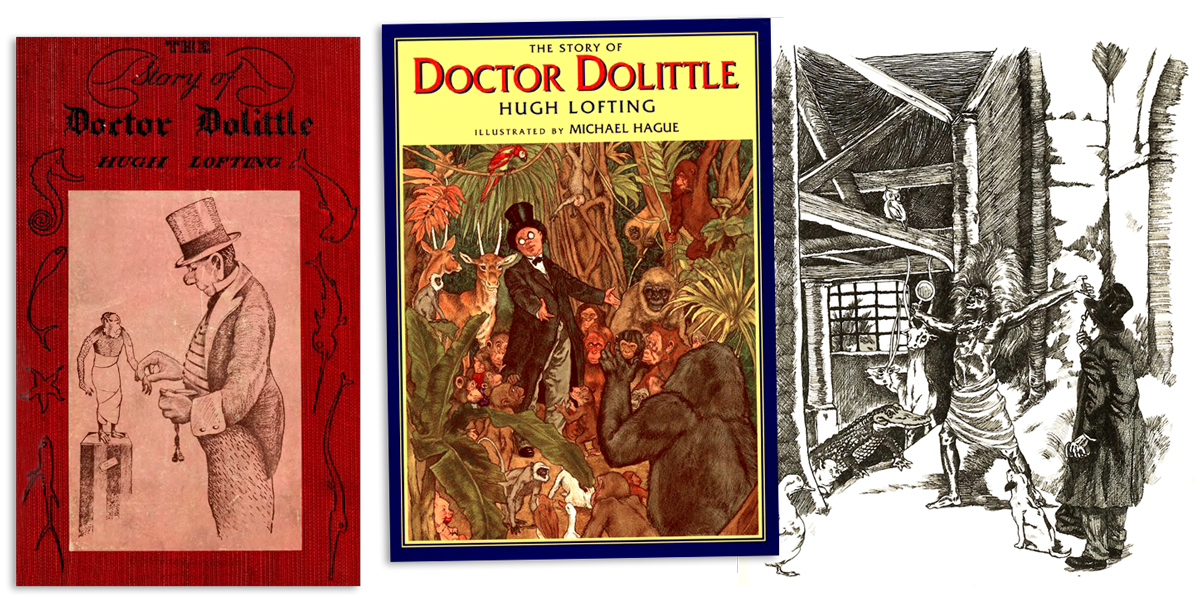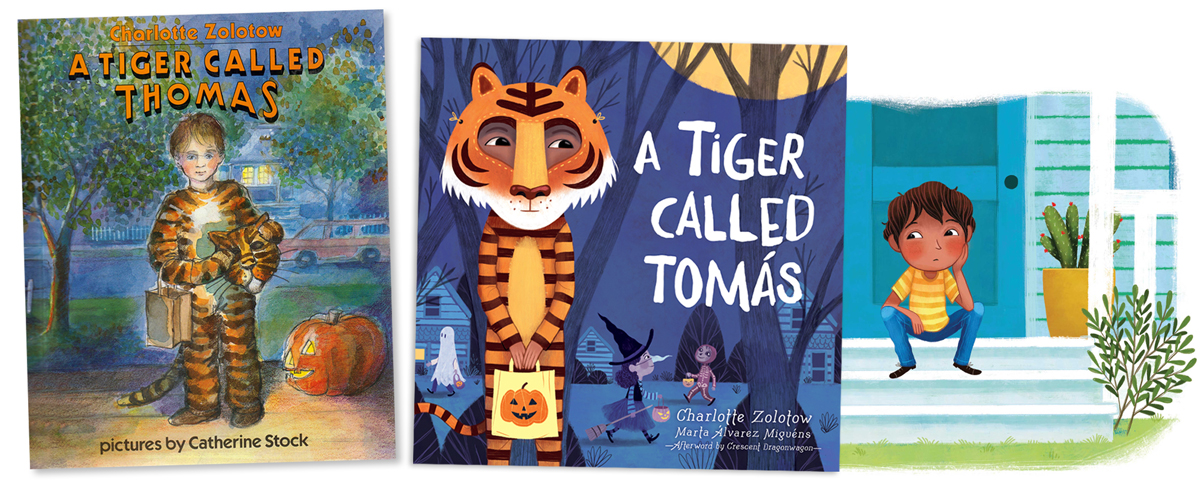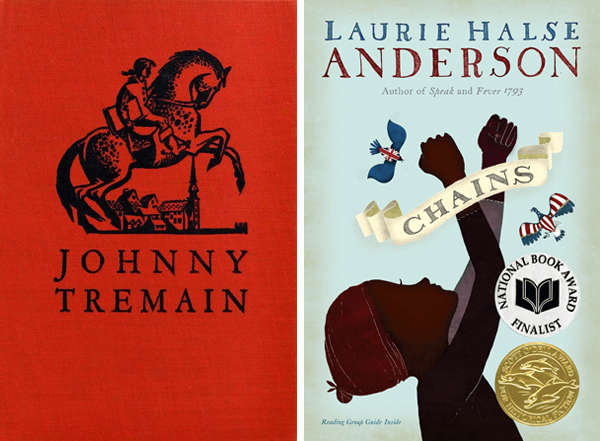Of Race and Reprints
Publishers are revising children's classics, including racist ones. Should they be?
 |
Hugh Lofting wrote and illustrated the original Story of Doctor Dolittle (left);
|
A few months ago, librarian Elisa Gall wrote an article for the “Reading While White” blog titled “The Privilege of Nostalgia.” Gall questioned the loyalty that grown-ups feel to problematic books they read when they were children. In a year when debate raged over the renaming of the Laura Ingalls Wilder Award because of racist sentiments in Wilder’s books, one section of Gall’s post struck me.
“Racist books, even those from the past, are not ever reflective of the way all people ‘thought back then,’” she wrote. “As long as there have been books, there have been people fighting racism in books—and today, with more knowledge, I can be thoughtful in choosing which books from my past I want to celebrate in my present.”
This raises an important question: What constitutes a classic? More significantly for today’s young readers, what elements from an old book are so important that they transcend a book’s problems?
Publishers have important decisions and responsibilities when reissuing older titles. Do you reprint a book that’s still on school reading lists around the country but has problematic elements? If so, do you keep everything as is, or update?
If educators believe in a title, they can turn its insensitivity, including racism, into teachable moments. Publishers can include author’s notes and afterwords by scholars that put the work in context. They can even rewrite entire sections.
Why do publishers still push older books that reflect attitudes and perceptions at odds with those we hold today? These reprints are lucrative and easy to produce. Despite the very real, harmful effects that racist, sexist, ableist, and other hurtful portrayals can have on children, the stream continues.
Still, with all the truly amazing works written for kids today, is all the effort poured into keeping these “canon” texts circulating really a good idea?
 |
The 1983 edition of Charlotte Zolotow’s A Tiger Called Thomas (left) and
|
Reissuing classics, altered or not
Publishers have taken varied approaches to reprinting problematic titles. One example is the 1997 edition of The Story of Doctor Dolittle by Hugh Lofting. Those familiar with Dolittle may be aware of its bald-faced racism. In their foreword to the 1997 reprint, Patricia and Fredrick McKissack discussed that this 1923 Newbery Medal winner went out of print in America in the 1970s for this very reason. The new edition has different art, and the McKissacks were allowed to make text changes, most significantly to the infamous Prince Bumpo chapter, in which a black prince begs the doctor to make him white. The prince now wishes to be a lion.
More than 20 years later, however, the book remains hugely problematic. Removing the overwhelming racism of an African prince buying into the myth of white beauty is one thing, but one doesn’t have to look closely at the new book to take issue with the fictionalized Jolliginki tribes’ stereotypical superstitions and violent tendencies, plus the author’s patronizing attitudes toward African people as a whole.
In 2018, a wide range of “classic” reprints were released, and some publications bereft of any kind of inclusivity were given an overhaul. One of the best was a new version of Charlotte Zolotow’s A Tiger Called Thomas. Originally released in 1963, the book was republished in 1988, 2003, and 2018. In the original, a white boy has moved to a new neighborhood, but his shyness prevents him from connecting with others. It’s only when he dons a tiger mask on Halloween and people recognize him—and express affection—that he feels able to form friendships.
In the 2003 edition, illustrated by Diana Cain Bluthenthal, Thomas was depicted as a young black boy in a mostly white neighborhood. The newest edition, renamed A Tiger Called Tomás, is illustrated by Spanish artist Marta Álvarez Miguéns and includes new Spanish terms and phrases. In an afterword, Zolotow’s daughter, Crescent Dragonwagon, writes, “I thought making Tomás Latino would add yet another layer to his universal story: showing that his isolation felt as much about language as it was about skin color. I feel Charlotte would have approved of Tomás.”
Meanwhile, other recent reprints rightly shine a new light on excellent older diverse books that deserve attention today. After Javaka Steptoe won a 2017 Caldecott Medal for Radiant Child, HarperCollins reprinted all the titles by his late father, John Steptoe, whose own books earned two Caldecott Honors, among other awards. The new board book edition of his amazing Baby Says gave me hope in a world with so much coldness and cruelty.
For slightly older readers, James Baldwin’s only book for children, Little Man, Little Man: A Story of Childhood, illustrated by the late French artist Yoran Cazac, has been republished by Duke University Press to justified fanfare. Baldwin’s story, set on a Harlem street, has a no-nonsense attitude toward childhood that feels both of its time and horrendously timely. The recently reprinted illustrated YA title The Middle Passage: White Ships/Black Cargo by Tom Feelings, chronicling life aboard a slave ship, is comparable to none. Also, Lee & Low published a 40th-anniversary special edition of Simon Ortiz’s The People Shall Continue in 2017. Ortiz’s book remains the essential framework for discussions of Native/Indigenous peoples of North America and their history for children. As author Joseph Bruchac said, “It’s a title that should be in every grade school library.”
 More context still needed
More context still needed
What happens when a book with racist elements is completely purged of them? Consider the latest Mary Poppins, reprinted in 2018 with art by Júlia Sardà (right). You will not find, and for good reason, the original 1934 version of the chapter “Bad Tuesday.” In it, young Michael is terrified by an “Eskimo with a spear, the Negro lady with her husband’s huge club, the Mandarin with a great curved sword, and the Red Indian with a tomahawk” who rush at him “full of revenge.” In a 1977 interview with P.L. Travers, Albert V. Schwartz called this a “racist nightmare in which Third World people turn—without the slightest provocation—into monsters to punish a white child.” Travers responded, “Remember, Mary Poppins was written a long time ago when racism was not as important.” Come again? The latest edition lacks even a note hinting at the chapter’s previous existence and that the angry humans are now angry animals. No characters of color appear in the book. As in the 1964 film, the London of P.L. Travers is a thoroughly white world. With the new Poppins films out this month featuring Lin-Manuel Miranda, you can’t help but wish new readers could have found a version of the book that doesn’t just erase the mistakes of the past, but corrects them.
 Contemporary pairings
Contemporary pairings
Rudyard Kipling’s works were also reissued in 2018, and with Kipling comes a particularly British sense of colonialism. This year saw the publication of The Elephant’s Child: How the Elephant Got His Trunk, now illustrated by Jonas Lauströer; The Complete Jungle Book, illustrated by Stuart Tresilian; and an original collection of stories inspired by Kipling, Into the Jungle: Stories for Mowgli by Katherine Rundell, illustrated by Kristjana S. Williams. The Jungle Book would have greatly benefited from an explanation by an Indian writer for children putting Kipling’s legacy in context. No such notation exists.
This is troubling, particularly considering that the underlying message of the original book was to show that Mowgli cannot exist in the jungle or the world of man with any comfort. Born in India, Kipling felt he had one foot in India and one in England. But because of his sense of racial superiority, allegiance to the country of his birth was impossible. It’s difficult to separate the man behind the poem “The White Man’s Burden,” in which the author laments how hard it is to keep going into countries to civilize savages, from his best-known children’s books. A simple note would contextualize Kipling’s stories.
In terms of American history, long before Miranda enthralled audiences young and old with Hamilton, kids’ primary fictionalized retelling of the American Revolution was Esther Forbes’s Johnny Tremain. Published at the height of World War II in 1943, this Newbery Award winner was celebrated for its fresh take, introducing young people to Revolutionary War history. It also presented an Anglo-centric view of that time. The latest reprint has a new opening section by the incomparably talented graphic novelist Nathan Hale, best known for his “Hazardous Tales” series.
The graphic section kicks new life into an old warhorse, but can only do so much. One hopes that Tremain will at least be paired by teachers with Laurie Halse Anderson’s Chains as a complementary text. There are multiple, excellent titles that can accompany problematic classics. Wilder’s titles, with their racist portrayals of Native American people, can be partnered with Louise Erdrich’s “Birchbark House” series. Those drawn to Mowgli and tigers can also teach Tiger Boy by Mitali Perkins, set in the Sunderbans of West Bengal.
 The same month as Gall’s “Privilege of Nostalgia” article posted, the New York Daily News announced that the city schools’ reading lists were biased against authors and characters of color, citing a recent study. “Roughly 90% of stories and books commonly used in public schools were written by white authors, with black, Hispanic and Asian writers accounting for just about 10% of authorship,” the article reported, and more than half of main characters in the stories were white, with few black, Latinx, and Asian characters.
The same month as Gall’s “Privilege of Nostalgia” article posted, the New York Daily News announced that the city schools’ reading lists were biased against authors and characters of color, citing a recent study. “Roughly 90% of stories and books commonly used in public schools were written by white authors, with black, Hispanic and Asian writers accounting for just about 10% of authorship,” the article reported, and more than half of main characters in the stories were white, with few black, Latinx, and Asian characters.
The nostalgia problem probably has something to do with this. Often, teachers rely so heavily on books from their own youth that even titles without overt bias can be problematic if they aren’t accompanied by books that meet the students’ needs.
It’s time to start looking elsewhere for classics beyond mainstream sources like the Newbery list. Consider the Phoenix Awards: Granted annually by the Children’s Literature Association, the award strives to “recognize books of high literary merit, which never won awards at the time publication, and which [are] still worthy of recognition.” The 2018 award went to Erdrich’sThe Birchbark House, with an honor going to Imani All Mine by Connie Porter. Wonderful titles can also be found by studying the Coretta Scott King Awards (dating back to 1970), the Pura Belpré Awards (1996), and the American Indian Youth Literature Awards (2006).
Meanwhile, as the reissues and reprints continue, let’s advocate that publishers give our children books with better context and clarity—and re-surface more excellent, overlooked books that everyone should know about. It’s what kids deserve.
RELATED
Tide’s Journey
The Smushkins: ABC Zoinks
Whose Footprint Is That?
Our World: Vietnam
The job outlook in 2030: Librarians will be in demand
The job outlook in 2030: Librarians will be in demand
ALREADY A SUBSCRIBER? LOG IN
We are currently offering this content for free. Sign up now to activate your personal profile, where you can save articles for future viewing






Add Comment :-
Be the first reader to comment.
Comment Policy:
Comment should not be empty !!!